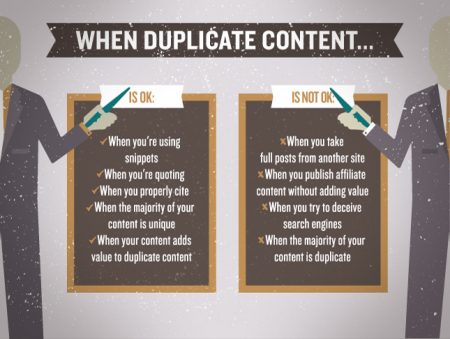How to Avoid Duplicate Content with Style

Unique content is important. Not only for search engines, but for your customers. If you only publish duplicate content, your readers could get bored, obviously, but you might actually get penalized on search engines.
Unique content will help you keep your readers from yawning (or worse, leaving your site and never coming back), and it will allow you to keep ranking for relevant keywords on search engines. Unique content is content that you created yourself, that has not been previously published, and content that is different from other content you’ve published. That’s pretty obvious, and it seems easy, but when you have to create a new social media post every day or a blog post every week, it can seem momentous.
So what happens if you get caught up? If you are too busy so you re-post some of your old content? According to Moz, one of the biggest issues is that search engines don’t know how to rank it. To give a little bit of backstory, search engines “crawl” your site, which means that they scan your content and essentially index the content on your site. If you write a post about the 10 cutest puppies this year and publish it in 2015 and then you write about the 10 cutest puppies this year and you republish that same content in 2016, search engines might be pretty confused. What if people search for the cutest puppies; what if they don’t specify the year? You can imagine the type of confusion that might cause.
According to Google if they notice duplicate content, they will do a few things:
- “When we detect duplicate content, such as through variations caused by URL parameters, we group the duplicate URLs into one cluster.”
- “We select what we think is the ‘best’ URL to represent the cluster in search results.”
- “We then consolidate properties of the URLs in the cluster, such as link popularity, to the representative URL.”
Just because duplicate content isn’t the best practice, it doesn’t mean it’s wrong: according to Google, “Duplicate content on a site is not grounds for action…unless it appears that the intent of the duplicate content is to be deceptive and manipulate search engine results.” But don’t get too freaked out. If you shared duplicate content, you don’t have to immediately destroy every duplicate post in the next five minutes.
When Duplicate Content is Okay
If you’re quoting or using snippets from another site, Google says you’re all good. That sort of content won’t get flagged as duplicate! If you do want to quote, make sure you follow best practices:
- Always use relevant anchor text. Say things like, “Cat Journal has some of the best cat photos around.” Don’t say, “Check out this journal here with the best cat photos around.”
- Shift your anchor text. Don’t keep saying, “According to Cat Journal,” try “In Cat Journal’s 2016 cat study…”
- Always cite your sources. It’s unethical (and might be considered illegal) to publish content without citing it.
When Duplicate Content is Not Okay
If you’re taking full posts from another website and publishing it on your website, that’s just wrong. But if you’re sharing bits of content from other sites, make sure you link back to the original source. It’s not only right; it will help Google figure out what to share.

Let’s look at an example based off an idea from Google Webmaster’s blog. If you’re part of an affiliate program and you link out to an Amazon listing, how can you expect to rank higher than Amazon, whose rank authority is incredible and whose page has a ton of viewers every day? If the content you’re linking to originates from Amazon, you’ll need to provide additional value if you actually want your content to rank.
What does additional value mean?
If you have an affiliate site, for example, and you copy everything directly from the source site, that’s bad form. And it doesn’t provide any additional value. But if you respond to the product, create new copy about the product, and follow your own brand’s guidelines for that copy, then you might be okay. You want to make sure that, if you do share affiliate content, it only takes up a small portion of your over all content. Essentially, you want to have some unique content. We suggest doing the following:
Rewrite the information on your own.
Create your own product listing with all new content.
Create new product titles and tags.
Write 300-500 words for each product.
Want to make sure you’re following guidelines? Check out Google’s Manual Action report.
A Path to Personality
If you go through a rebrand or if you want to re-use some older content, that’s totally fine. Just make sure you re-tool a bit.
Include relevant new information. If you wrote an old blog about a specific type of cat, and there’s been new studies done on that cat, bring that info in so your new post can be up to date.
If there’s a chunk of content that’s still relevant, but you don’t want to copy it exactly, tweak it and turn it into an infographic or a shareable image. You’ll still get to use your relevant content, but readers will be able to see it in a new way.
Transform your content into a guidebook. Do you have 15 articles about how to adopt a cat? Refresh it by turning it into an ebook. Make sure that you adjust the content so it’s relevant and timeless. Remove instances of time (“last week, I…”; “tomorrow, we want to…”) format your text with proper page numbers; add in traditional eBook formatting (a table of contents, a cover page, an acknowledgements page, if necessary, and a bio at the end of the book); add in unique design elements (a border, a unique icon, etc.); add in extras (free resources, shareable info, and any printouts); and link to it directly from your website or offer paid access to customers who subscribe.
Attack it from a new angle. Been thinking about your content for a while? Approach it in a new way. If you wrote a post about the fastest cars coming out this year, you can retool that idea to focus on new laws surrounding speed limits; how to stay safe while driving these cars; or you can write a gift guide using the same cars. You’ll keep some of the relevant info the same, but you’ll have a few different articles out of that one idea.
*If someone is reposting your content without citing it, you can report them.
Now go ahead and reformat, duplicate when necessary, but make sure you add valuable unique content whenever possible! Good luck.